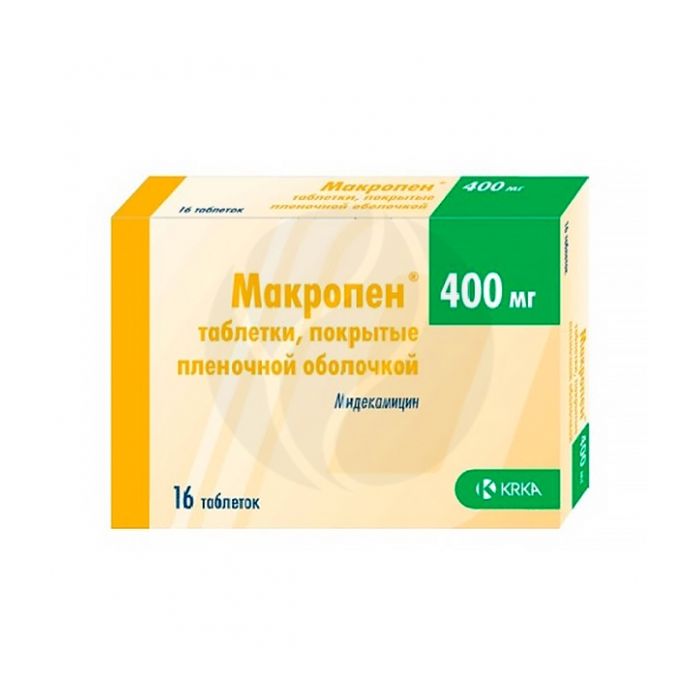Macropen tablets 400mg, No. 16
Expiration Date: 05/2027
Russian Pharmacy name:
Макропен таблетки 400мг, №16
Infectious and inflammatory diseases caused by microorganisms sensitive to the drug:
respiratory tract infections, incl. caused by atypical pathogens (mycoplasma, legionella, chlamydia and Ureaplasma urealyticum) - tonsillopharyngitis, acute otitis media, sinusitis, exacerbation of chronic bronchitis, community-acquired pneumonia;
infections of the genitourinary tract caused by atypical pathogens - mycoplasma, legionella, chlamydia and Ureaplasma urealyticum;
infections of the skin and subcutaneous tissue;
enteritis caused by bacteria of the genus Campylobacter;
diphtheria and whooping cough (treatment and prevention).
Individual. Inside for adults - an average of 400 mg 3 times / day; the maximum daily dose is 1.6 g; children - 30-50 mg / kg / day in 2 divided doses. In severe infections, the frequency of admission can be increased up to 3 times / day. Duration of treatment is 7-14 days.
Film-coated tablets of white color, round, slightly biconvex, with beveled edges and a notch on one side; at the break there is a white mass with a rough surface.
1 tab. midecamycin 400 mg
Excipients: potassium polacrilin, magnesium stearate, talc, microcrystalline cellulose.
Hepatic and / or renal failure
hypersensitivity to midecamycin and other macrolides.
pharmachologic effect
Antibiotic of the macrolide group. The mechanism of action is associated with inhibition of protein synthesis in bacterial cells. In low doses it has a bacteriostatic effect, in high doses it is bactericidal.
Active against gram-positive bacteria: Staphylococcus spp., Streptococcus spp., Corynebacterium diphtheriae; gram-negative bacteria: Listeria monocytogenes, Neisseria gonorrhoeae, Neisseria meningitidis, Bordetella pertussis, some strains of Haemophilus influenzae, Legionella pneumophila; anaerobic bacteria: Clostridium spp.
Active against Mycoplasma pneumoniae, Erysipelothrix spp., Ureaplasma urealyticum, Chlamydia (including Chlamydia trachomatis), Mycoplasma hominis.
Pharmacokinetics
After oral administration, it is rapidly and completely absorbed from the gastrointestinal tract. Concentrations exceeding those found in serum are created in the internal organs (especially in the lungs, parotid and submandibular glands) and skin after 1-2 hours. At a therapeutic concentration in the blood and tissues it remains for 6 hours. It is metabolized in the liver with the formation of two pharmacologically active metabolites. It is excreted mainly in the bile, a small part - by the kidneys (<5%).
Side effect
Possibly: skin rash.
Rarely: anorexia, a feeling of heaviness in the epigastrium, nausea, vomiting, diarrhea, a transient increase in the activity of hepatic transaminases and the concentration of bilirubin in the blood serum (in predisposed patients).
Application during pregnancy and lactation
With caution, midecamycin is prescribed during pregnancy and lactation, only in cases where the expected therapeutic effect for the mother outweighs the potential risk of side effects in the fetus or child.
If necessary, use during lactation should decide on the termination of breastfeeding.
Application for violations of liver function
Contraindicated in liver failure.
Application for impaired renal function
Contraindicated in renal failure.
Application in children
Application is possible according to the dosage regimen.
special instructions
With prolonged use, it is recommended to monitor laboratory parameters characterizing liver function, especially in patients with a history of liver disease.
Drug interactions
With simultaneous use with cyclosporine, warfarin - their excretion decreases; with ergot alkaloids, carbamazepine - the intensity of their metabolism in the liver decreases.

